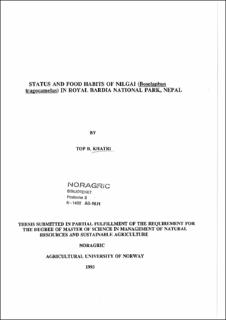| dc.contributor.advisor | Wegge, Per | |
| dc.contributor.author | Khatri, Top B. | |
| dc.coverage.spatial | Nepal | en_US |
| dc.date.accessioned | 2020-07-18T19:21:47Z | |
| dc.date.available | 2020-07-18T19:21:47Z | |
| dc.date.issued | 1993 | |
| dc.identifier.uri | https://hdl.handle.net/11250/2669598 | |
| dc.description.abstract | A six months (August 1992 - January 1993) study on the status and food habits of nilgai (Boselaphus tragocamelus) was carried out in Royal Bardia National Park, south western Nepal. Methods used were questionnaire surveys, field observations and microhistological analysis of faecal material. A total of 57-86 animals were estimated to exist in nine different semi-isolated subpopulations inside and outside the park, reflecting a decline of 80-90% since the 1970's. A combination of high poaching, tiger predation and habitat deterioration both inside and outside the park was identified as the major cause of the decline. | en_US |
| dc.description.sponsorship | NORAD | en_US |
| dc.language.iso | eng | en_US |
| dc.publisher | Norwegian University of Life Sciences, Ås | en_US |
| dc.rights | Attribution-NonCommercial-NoDerivatives 4.0 Internasjonal | * |
| dc.rights.uri | http://creativecommons.org/licenses/by-nc-nd/4.0/deed.no | * |
| dc.title | Status and food habits of nilgai (Boselaphus tragocamelus) in Royal Bardia National Park, Nepal | en_US |
| dc.type | Master thesis | en_US |

